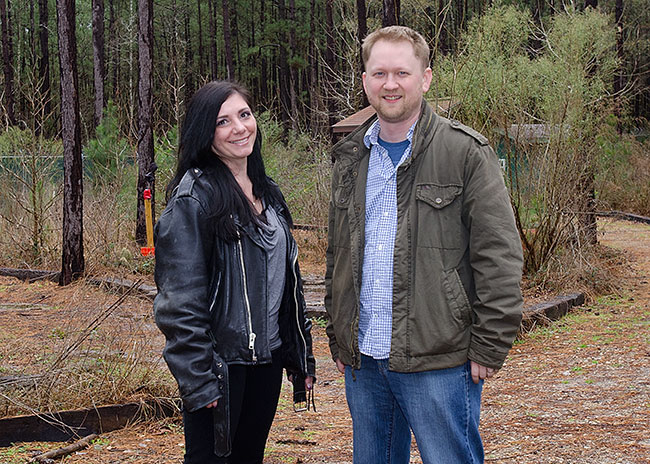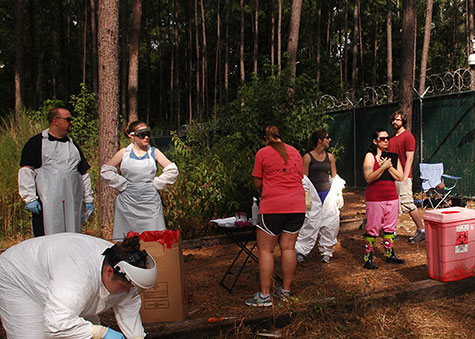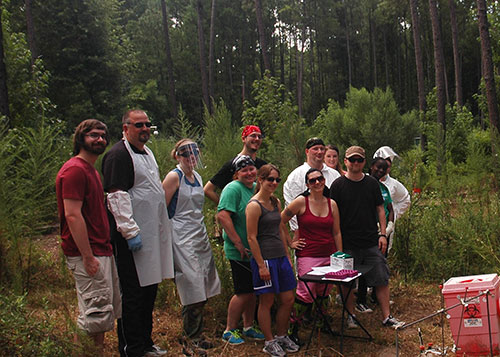Team’s Microbiology Research Works To Produce New Forensics Tool
Feb. 26, 2014
SHSU Media Contact: Jennifer Gauntt
Story By: Flori Meeks
 |
| Sibyl Bucheli and Aaron Lynne are working to find a more effective forensic tool for determining the time of a person's death through the bacteria that's already on a person's body using next-generation sequencing and bacteria collected from bodies at the Southeast Texas Applied Forensic Science Facility to identify mutations and variations in DNA. —Photo by Brian Blalock |
Sibyl Bucheli and Aaron Lynne envision a time when crime-scene investigators look to bacteria to bring them a step closer to solving their cases.
Bucheli, an entomologist with Sam Houston State University’s Department of Biological Sciences, and Lynne, an assistant professor of molecular microbiology, have received a three-year, $300,000 grant from the National Institute of Justice to examine the microbiology of human decomposition.
“We hope that by understanding how the bacteria that inhabits a corpse changes over time, we can apply it to forensic tools, including determining the time of death, or the post-mortem interval,” Bucheli said.
There is a window of time when a coroner or medical examiner can estimate a body’s time of death based on body temperature, signs of discoloration or rigor mortis.
“After the body cools, those processes become less reliable,” Bucheli said.
In some cases, insects on the body sometimes can provide information, but they aren’t always present.
“Our model is based on bacteria that’s already on the body,” Lynne said. “There’s no perfect way to determine how long a body has been decomposing, but it might be possible to use our model with other models for a more accurate picture.”
Bucheli and Lynne first began conducting research together about three years ago. Bucheli already was working at the university’s Southeast Texas Applied Forensic Science Facility, also known as “the body farm,” where scientists have access to corpses that are donated for scientific research. The SHSU facility is one of four in the United States.
“Sibyl came to me with a question: Is there a way to determine what bacteria is on the body after death and how that bacteria changes over time?” Lynne said.
 |
| Helping Bucheli and Lynne on their research are a team of biologists and biology students in SHSU's undergraduate and graduate programs, who help with the collection, cataloging and storage of the bacteria. —Submitted photos |
 |
Bucheli and Lynne decided to work together to find the answers.
“I’m a biologist at heart,” Bucheli said. “What really got me interested in this research is the flies that show up immediately after death. I think the smell of the metabolic byproduct of bacteria attracts them.”
The work Bucheli and Lynne are doing now utilizes next-generation sequencing to identify the bacteria on the corpses and how it changes over time. Next-generation sequencing is an advanced technique that identifies mutations and variants in DNA.
“It’s culture independent and relatively inexpensive,” Lynne said.
The grant from the NIJ allows the researchers to pay a six-person team of undergraduates and graduate students to assistant them.
The team is collaborating with Joe Petrosino, director of the Alkek Center of Metagenomics and Microbiome Research in Baylor College of Medicine’s department of molecular virology and microbiology, along with researchers from University of Colorado Boulder, Texas A&M University and Chaminade University in Honolulu.
“We have a very unique situation with the body farm and the new sequencing technology,” Lynne said.
During the next three years, the team will be taking approximately 5,000 bacteria samples.
The process involves placing bodies outdoors, allowing them to decompose and taking daily swabs from different parts of the bodies.
“Without the support of the STAFS facility and the donation of the cadavers, we wouldn’t be able to do this work,” Bucheli said. “There are a lot of concerns about donating a family member’s body to science, a lot of unknowns, but donations like that are really important.”
Graduate biology student Daniel Haarmann, who earned his bachelor’s degree in biology from SHSU in 2011, has been handling the research team’s sampling schedule, supply logistics, cataloging of samples and sample storage.
“This is an area that has not really been looked at very well,” said Haarmann, who grew up in Shepherd. “Decomposition is a very complicated process between the insects, temperature, bacteria and all of the different scenarios.”
Lauren Smith, a senior biology major from Houston, is a team leader for the research project.
“It’s really interesting to see the different sets of bodies we placed, the differences in their decomposition,” Smith said. “This research can be used for so much. If remains are found, we’ll be able—just from the bacteria on the body—determine how long it’s been there.”
Bucheli said she’s excited about the long-term potential of this research as well.
“People suffer in crime situations, the families of the victim and of the suspect,” she said. “I feel if we can help law enforcement by providing very good information, we can help alleviate some of that suffering.”
- END -
This page maintained by SHSU's Communications Office
Associate Director: Julia May
Manager: Jennifer Gauntt
Located in the 115 Administration Building
Telephone: 936.294.1836; Fax: 936.294.1834
Please send comments, corrections, news tips to Today@Sam.edu.

 SamWeb
SamWeb My Sam
My Sam E-mail
E-mail

